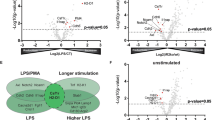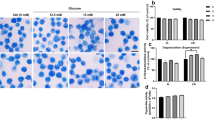Abstract
The results of binding studies suggest the presence of histamine H1-receptors in human monocytes, but it is not known whether these receptors are functionally active. This prompted us to study the effects of histamine (HA) on cytosolic Ca2+ concentration ([Ca2+]i) and superoxide anion (O2 − ) formation in HL-60 cells differentiated towards monocytes with 1α,25-dihydroxychole-calciferol. In HL-60 monocytes, HA increased [Ca2+]i with a half-maximal effect at 8 μM and a maximum at 30–100 μM. Pertussis toxin (PTX) partially inhibited the stimulatory effects of HA on [Ca2+]i. Betahistine, a weak partial H1-receptor agonist, also increased [Ca2+]i, whereas H2- and H3-receptor agonists were ineffective. H1- but not H2- and H3-receptor antagonists inhibited HA induced rises in [Ca2+]i. HA-induced rises in [Ca2+]i were desensitized in a homologous manner and were also inhibited by the activator of protein kinase C, 4\-phorbol 12-myristate 13-acetate. Various protein kinase C inhibitors did not interfere with homologous desensitization. The stimulatory effects of HA on [Ca2+]i were completely dependent on the presence of extracellular Ca2+ and were inhibited by the blocker of non-selective cation (NSC) channels, 1-{\-[3-(4-methoxyphenyl)propoxyl]-4-methoxyphenethyl}-1 H-imidazole hydrochloride (SK & F 96365). HA was much less effective than the chemotactic peptide, N-formyl-l-methionyl-l-leucyl-l-phenylalanine (fMLP), to induce rises in [Ca2+]i. Unlike fMLP, HA did not activate O2 − formation. Our data indicate that HL-60 monocytes possess H1-receptors coupled to heterotrimeric regulatory guanine nucleotide-binding proteins (G-proteins) of the Gi-family and PTX-insensitive G-proteins which mediate activation of NSC channels without concomitant activation of Ca2+ mobilization from intracellular stores, that homologous desensitization of HA-induced Ca2+ influx is independent of protein kinase C and that the stimulatory effect of HA on Ca2+ influx is too small to result in activation of O2 − formation.
Similar content being viewed by others
References
Aloj SM, Liguoro D, Klang JG, Smallridge RC (1993) Purinergic (P2) receptor-operated calcium entry into rat thyroid cells. Biochem Biophys Res Commun 195:1–7
Alonso Torre SR, Alvarez J, Montero M, Sanchez A, Garcia-Sancho J (1993) Control of Ca2+ entry into HL60 and U937 human leukemia cells by the filling state of the intracellular Ca2+ stores. Biochem J 289:761–766
Amatruda TT, Steele DA, Slepak VZ, Simon MI (1991) Gα16, a G protein α subunit specifically expressed in hemopoietic cells. Proc Natl Acad Sci USA 88:5587–5591
Burde R, Seifert R, Buschauer A, Schultz G (1989) Histamine inhibits activation of human neutrophils and HL-60 leukemic cells via H2-receptors. Naunyn Schmiedebergs Arch Pharmacol 340: 671–678
Burde R, Buschauer A, Seifert R (1990) Characterization of histamine H2-receptors in human neutrophils with a series of guanidine analogues of impromidine. Are cell type-specific H2-receptors involved in the regulation of NADPH oxidase? Naunyn Schmiedebergs Arch Pharmacol 341:455–461
Buschauer A (1989) Synthesis and in vitro pharmacology of arpromidine and related phenyl(pyridylakyl)guanidines, a potential new class of positive inotropic drugs. J Med Chem 32:1963–1970
Buschauer A, Schunack W, Arrang J-M, Garbarg M, Schwartz J-C, Young JM (1989) Histamine receptors. In: Williams M, Glennon RA, Timmermans PBMWM (eds) Clinical pharmacology, Vol 13. Receptor pharmacology and function. Dekker, New York, pp 293–348
Cameron W, Doyle K, Rocklin RE (1986) Histamine type I (H1) receptor radioligand binding studies on normal T cell subsets, B cells and monocytes. J Immunol 136:2116–2120
Clapham DE (1993) A mysterious new influx factor? Nature 364:763–764
Dawra R, Saluja AK, Rünzi M, Steer ML (1993) Inositol trisphosphate-independent agonist-stimulated calcium influx in rat pancreatic acinar cells. J Biol Chem 268:20237–20242
Demaurex N, Lew DP, Krause K-H (1992) Cyclopiazonic acid depletes intracellular Ca2+ stores and activates an influx pathway for divalent cations in HL60 cells. J Biol Chem 267:2318–2324
Didsbury JR, Uhing RJ, Tomhave E, Gerard C, Gerard N, Snyderman R (1991) Receptor class desensitization of leukocyte chemoattractant receptors. Proc Natl Acad Sci USA 88:11564–11568
Driver AG, Kukoly CA, Bennett TE (1989) Expression of histamine H1 receptors on cultured histiocytic lymphoma cells. Biochem Pharmacol 38:3083–3091
Fujimoto K, Horio Y, Sugama K, Ito S, Liu YQ, Fukui H (1993) Genomic cloning of the rat histamine H1 receptor. Biochem Biophys Res Commun 190:294–301
Gespach C, Abita J-P (1982) Human polymorphonuclear neutrophils. Pharmacological characterization of histamine receptors mediating the elevation of cyclic AMP. Mol Pharmacol 21:78–85
Gespach C, Saal F, Cost H, Abita J-P (1982) Identification and characterization of surface receptors for histamine in the human promyelocytic leukemia cell line HL60. Comparison with human peripheral neutrophils. Mol Pharmacol 22:547–553
Gespach C, Cost H, Abita J-P (1985) Histamine H2 receptor activity during the differentiation of the human monocytec-like cell line U-937. Comparison with prostaglandins and isoproterenol. FEBS Lett 184:207–213
Hill SJ (1990) Distribution, properties, and functional characteristics of three classes of histamine receptors. Pharmacol Rev 42:45–83
Horio Y, Mori Y, Higuchi I, Fujimoto K, Ito S, Fukui H (1993) Molecular coloning of the guinea-pig histamine H1 receptor gene. J Biochem 114:408–414
Hruska KA, Bar-Shavit Z, Malone JD, Teitelbaum S (1988) Ca2+ priming during vitamin D-induced monocytec differentiation of a human leukemia cell line. J Biol Chem 263:16039–16044
Jungblut PR, Seifert R (1990) Analysis by high-resolution two-dimensional electrophoresis of differentiation-dependent alterations in cytosolic protein pattern of HL60 leukemic cells. J Biochem Biophys Meth 21:47–58
Krautwurst D, Seifert R, Hescheler J, Schultz G (1992) Formyl peptides and ATP stimualte Ca2+ and Na+ inward currents through non-selective cation channels via G-proteins in dibutyryl cyclic AMP-differentiated HL-60 cells. Involvement of Ca2+ and Na+ in the activation of \-glucuronidase release and superoxide production. Biochem J 288:1025–1035
Lefkowitz RJ (1993) G protein-coupled receptor kinases. Cell 74:409–412
Martiny-Baron G, Kazanietz MG, Mischak H, Blumberg PM, Kochs G, Hug H, Marmé D, Schächtele C (1993) Selective inhibition of protein kinase C isozymes by the indolcarbazole Gö 6976. J Biol Chem 268:9194–9197
Merritt JE, Armstrong WP, Benham CD, Hallam TJ, Jacob R, Jaxa-Chamiec A, Leigh BK, McCarthy SA, Moores KE, Rink TJ (1990) SK&F 96365, a novel inhibitor of receptor-mediated calcium entry. Biochem J 271:515–522
Monk PN, Partridge LJ (1993) Characterization of a complement-fragment-C5a-stimulated calcium-influx mechanism in U937 monocytec cells. Biochem J 295:679–684
Murphy PM, Eide B, Goldsmith P, Brann M, Gierschik P, Spiegel A, Malech HL (1987) Detection of Giα in HL60 cells. FEBS Lett 221:81–86
Nonaka T, Mio M, Doi M, Tasaka K (1992) Histamine-induced differentiation of HL-60 cells. The role of cAMP and protein kinase A. Biochem Pharmacol 44:1115–1121
Norgauer J, Dobos G, Kownatzki E, Dahinden C, Burger R, Kupper R, Gierschik P (1993) Complement C3a stimulates Ca2+ influx in neutrophils via a pertussis-toxin-sensitive G protein. Eur J Biochem 217:289–294
Ostrem VK, Tanaka Y, Prahl J, DeLuca HF, Ikekawa N (1987) 24- and 26-homo-1,25-dihydroxyvitamin D3: Preferential activity in inducing differentiation of human leukemia cells HL-60 in vitro. Proc Natl Acad Sci USA 84:2610–2614
Pollock K, Creba J, Mitchell F, Milligan G (1990) Stimulus-response coupling in FMLP-stimulated U937 monocytes: Effect of differentiation on Gi2 expression. Biochem Biophys Acta 1051:71–77
Randriamampita C, Tsien TY (1993) Emptying of intracellular Ca2+ stores releases a novel small messenger that stimulates Ca2+ influx. Nature 364:809–814
Rosenthal W, Koesling D, Rudolph U, Kleuss C, Pallast M, Yajima M, Schultz G (1986) Identification of the 35-kDa \-subunit of guanine-nucleotide-binding proteins by an antiserum raised against transducin. Eur J Biochem 158:255–263
Rudolph U, Koesling D, Hinsch K-D, Seifert R, Bigalke M, Schultz G, Rosenthal W (1989) G-protein α-subunits in cytosolic and membranous fractions of human neutrophils. Mol Cell Endocrinol 63:143–153
Schunack W (1987) What are the differences between H2-receptor antagonists? Aliment Pharmacol Therap 1:4935–5035
Schwaner I, Seifert R, Schultz G (1992) Receptor-mediated increases in cytosolic Ca2+ in the human erythroleukemia cell line involve pertussis toxin-sensitive and -insensitive pathways. Biochem J 281: 301–307
Seligmann BE, Flechter MP, Gallin JI (1983) Histamine modulation of human neutrophil oxidative metabolism, locomotion, degranulation, and membrane potential changes. J Immunol 130:1902–1909
Seifert R, Schultz G (1987) Reversible activation of NADPH oxidase in membranes of HL-60 leukemic cells. Biochem Biophys Res Commun 146:1296–1302
Seifert R, Burde R, Schultz G (1989) Activation of NADPH oxidase by purine and pyrimidine nucleotides involves G proteins and is potentiated by chemotactic peptides. Biochem J 259:813–819
Seifert R, Höer A, Offermanns S, Buschauer A, Schunack W (1992) Histamine increases cytosolic Ca2+ in dibutyryl-cAMP-differentiated HL-60 cells via H1 receptors and is an incomplete secretagogue. Mol Pharmacol 42:227–234
Sozzani S, Molino M, Locati M, Luini W, Cerletti C, Vecchi A, Mantovani A (1993) Receptor-activated calcium influx in human monocytes exposed to monocyte chemotactic protein-1 and related cytokines. J Immunol 150:1544–1553
Strathmann MP, Simon MI (1991) Gα12 and Gα13 subunits define a fourth class of G-protean a subunits. Proc Natl Acad Sci USA 88:5582–5586
Tamaoki T, Nomoto H, Takahashi I, Kato Y, Morimoto M, Tomita F (1986) Staurosporine, a potent inhibitor of phospholipid/Ca++ dependent protein kinase. Biochem Biophys Res Commun 135: 397–402
Tohkin M, Morishima N, Iiri T, Takahashi K, Ui M, Katada T (1991) Interaction of guanine-nucleotide-binding regulatory proteins with chemotactic peptide receptors in differentiated human leukemic HL-60 cells. Eur J Biochem 195:527–533
Wenzel-Seifert K, Seifert R (1990) Nucleotide-, chemotactic peptide-and phorbol ester-induced exocytosis in HL-60 leukemic cells. Immunobiology 181:298–316
Werlen G, Belin D, Conne B, Roche E, Lew DP, Premki M (1993) Intracellular Ca2+ and the regulation of early response gene expression in HL-60 myeloid leukemia cells. J Biol Chem 268:16596–16601
Yamashita M, Fukui H, Sugama K, Horio Y, Ito S, Mizuguchi H, Wada H (1991) Expression cloning of a cDNA encoding the bovine histamine H1 receptor. Proc Natl Acad Sci USA 88:11515–11519
Zingel V, Schunack W (1993) Agonisten des Histamin H1-Rezeptors: Struktur und Pharmakologie. Pharmazie 48:483–493
Author information
Authors and Affiliations
Additional information
Correspondence to: R. Seifert at the above address
Rights and permissions
About this article
Cite this article
Seifert, R., Grünbaum, L. & Schultz, G. Histamine H1-receptors in HL-60 monocytes are coupled to Gi-proteins and pertussis toxin-insensitive G-proteins and mediate activation of Ca2+ influx without concomitant Ca2+ mobilization from intracellular stores. Naunyn-Schmiedeberg’s Arch Pharmacol 349, 355–361 (1994). https://doi.org/10.1007/BF00170880
Received:
Accepted:
Published:
Issue Date:
DOI: https://doi.org/10.1007/BF00170880




